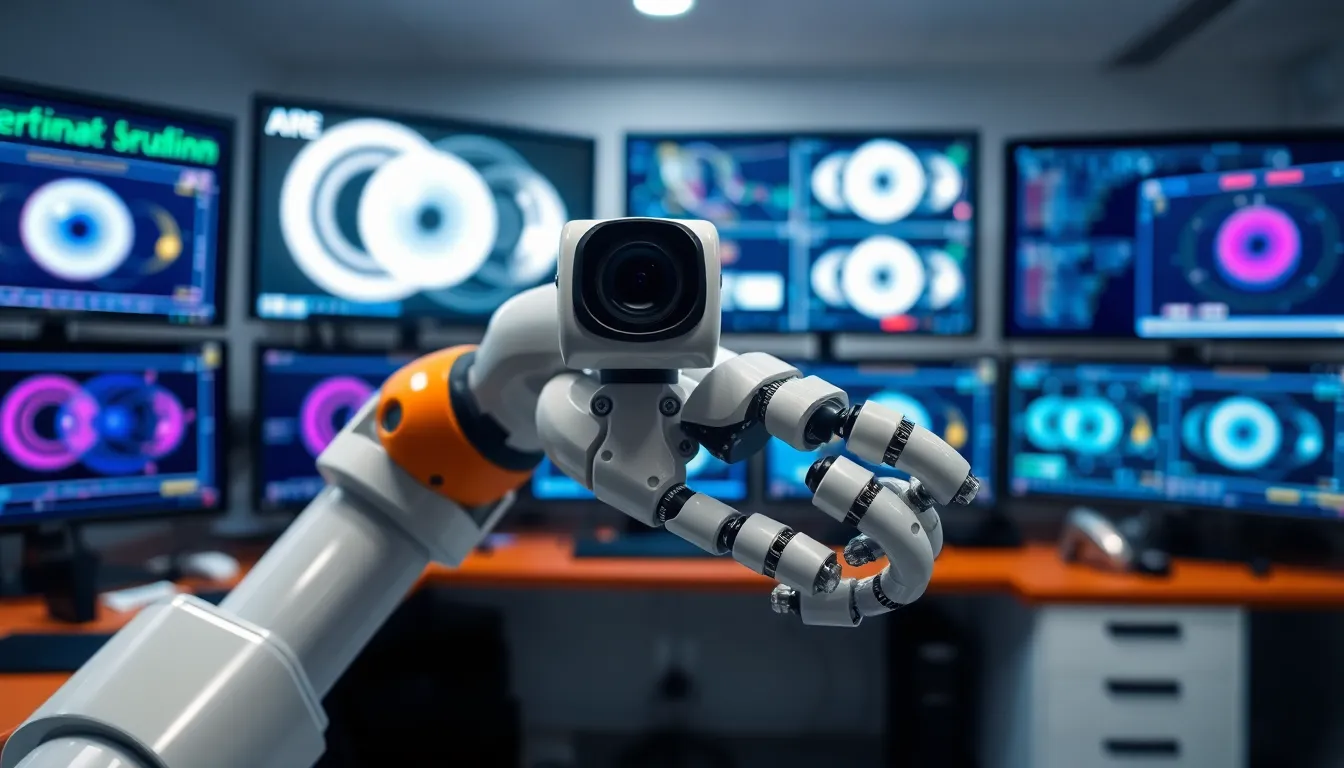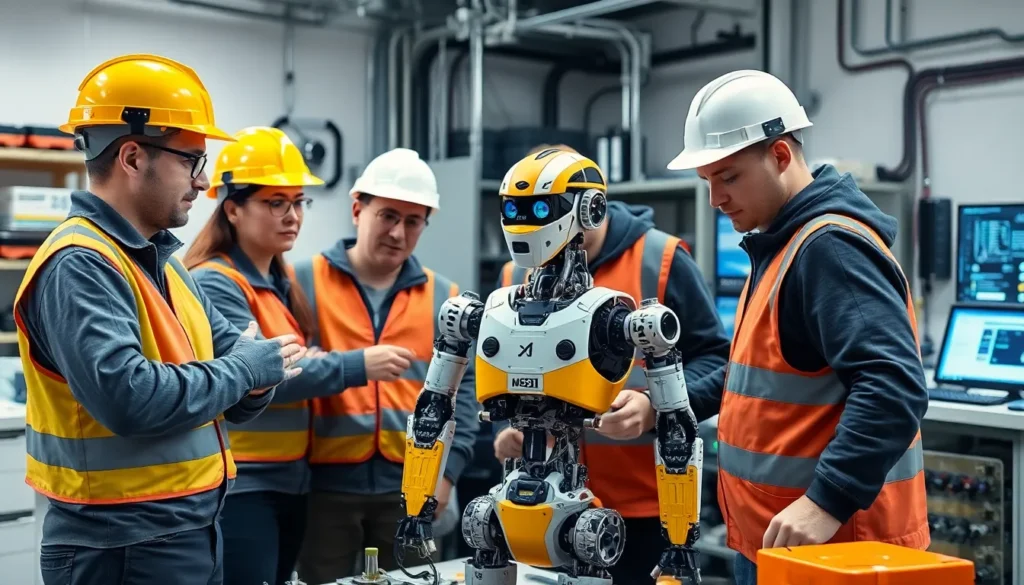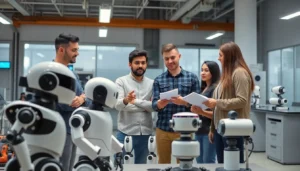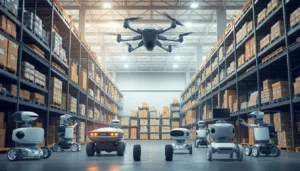In a world where technology evolves at lightning speed, computer vision robotics stands at the forefront of innovation. This fascinating field merges artificial intelligence with robotics, enabling machines to interpret and understand visual data just like humans. From self-driving cars to automated manufacturing systems, the applications are vast and transformative.
As industries increasingly adopt these intelligent systems, the demand for advanced computer vision capabilities continues to grow. By leveraging sophisticated algorithms and machine learning techniques, robots can now recognize objects, navigate complex environments, and make real-time decisions. This evolution not only enhances productivity but also opens new avenues for creativity and efficiency across various sectors.
Table of Contents
ToggleOverview of Computer Vision Robotics
Computer vision robotics combines artificial intelligence and robotics to facilitate visual data interpretation akin to human capabilities. This technology empowers machines to analyze, understand, and act upon visual information, leading to advancements in numerous sectors. High-demand applications include self-driving vehicles, industrial automation, agricultural robotics, and security surveillance.
Key Components of Computer Vision Robotics
- Image Acquisition: Sensors, such as cameras and LIDAR, capture the visual data for processing.
- Preprocessing: Techniques like noise reduction and image enhancement improve data quality for analysis.
- Feature Extraction: Algorithms identify and extract relevant features from images, such as edges and textures.
- Object Recognition: Models categorize and identify objects within images, facilitating interaction with the environment.
- Navigation: Systems compute paths and maneuver through complex surroundings, ensuring safety and efficiency.
Applications of Computer Vision Robotics
- Autonomous Vehicles: Self-driving cars leverage computer vision to interpret road conditions and detect obstacles, enhancing traffic safety.
- Manufacturing: Robots equipped with vision systems perform quality control and automate assembly tasks, improving efficiency.
- Healthcare: Medical robots utilize vision technology for tasks like surgery assistance and patient monitoring, enhancing precision.
- Agriculture: Drones and ground robots identify and analyze crop health, optimizing resource allocation.
Future Trends in Computer Vision Robotics
- Deep Learning Integration: Enhanced algorithms support improved object recognition and prediction capabilities.
- Increased Sensor Fusion: Combining data from different sensor types expands operational capabilities and accuracy.
- Edge Computing: Process intensively on-device reduces latency and bandwidth requirements for real-time decision-making.
- Human-Robot Interaction: Advanced vision systems promote seamless collaboration between humans and robots in diverse environments.
Computer vision robotics marks a pivotal development in automation and artificial intelligence, driving innovation in numerous fields. Its capacity to enhance operational efficiency and safety continues to shape the future of technology.
Key Technologies in Computer Vision Robotics

Computer vision robotics relies on several key technologies that enhance the capabilities of machines to interpret and interact with visual information. Two primary components include machine learning algorithms and sensor technologies.
Machine Learning Algorithms
Machine learning algorithms serve as the backbone of computer vision robotics by enabling systems to learn from data. These algorithms analyze images and identify patterns, improving object recognition accuracy. Common types of algorithms include:
- Convolutional Neural Networks (CNNs): CNNs excel in image processing and classification tasks. They automatically identify features, making them ideal for recognizing complex objects.
- Support Vector Machines (SVMs): SVMs classify data by finding the optimal hyperplane that separates different classes. They work well in applications like facial recognition.
- Deep Learning Frameworks: Frameworks such as TensorFlow and PyTorch facilitate the development of deep learning models, further enhancing image analysis and interpretation capabilities.
Sensor Technologies
Sensor technologies play a critical role in acquiring high-quality visual data. Various sensor types contribute to the robustness of computer vision systems, including:
- Cameras: Digital cameras capture detailed images and videos, providing essential data for processing and analysis. High-resolution and stereo cameras enhance depth perception.
- LiDAR Sensors: LiDAR uses laser light to generate precise 3D maps of environments. This technology is particularly useful for autonomous navigation and obstacle detection.
- Infrared Sensors: Infrared sensors detect heat signatures, allowing systems to see in low-light conditions. Applications include night vision and thermal imaging.
These technologies collectively enable computer vision robotics to achieve remarkable accuracy and efficiency across diverse applications, from autonomous vehicles to automated manufacturing processes.
Applications of Computer Vision Robotics
Computer vision robotics offers diverse applications that revolutionize multiple industries. Its capabilities enable enhanced efficiency, accuracy, and safety in various environments.
Industrial Automation
Industrial automation represents a key application area for computer vision robotics. Robots equipped with advanced vision systems perform tasks like quality control, defect detection, and assembly line inspection. These systems identify minute imperfections in products, ensuring that only items meeting quality standards proceed. Automation improves efficiency by reducing human error and speeding up production cycles. For instance, automotive manufacturers leverage these technologies to monitor assembly lines, resulting in higher precision and lower operational costs.
Healthcare Innovations
Healthcare innovations harness computer vision robotics to improve patient outcomes. Surgical robots utilize vision systems for enhanced precision in minimally invasive procedures. These robots recognize anatomical structures, guiding surgeons during operations while minimizing risks. Additionally, diagnostic imaging systems analyze medical images with impressive accuracy, aiding in early disease detection. For example, computer vision aids radiologists by highlighting potential areas of concern in X-rays or MRIs. This application contributes to timely treatments and improved patient care.
Overall, applications across industrial automation and healthcare demonstrate the transformative impact of computer vision robotics, enhancing performance and driving forward advancements in technology.
Challenges in Computer Vision Robotics
Computer vision robotics faces several significant challenges that impact its effectiveness and reliability. Addressing these challenges is crucial for the continued advancement and application of this technology across various sectors.
Data Quality and Processing
Data quality plays a vital role in the performance of computer vision systems. High-quality images are essential for accurate feature extraction and object recognition. Factors like lighting conditions, image resolution, and noise can degrade data quality, leading to misinterpretations. Furthermore, preprocessing techniques must effectively address issues such as image distortion and occlusion for proper analysis. Continuous advancements in machine learning algorithms provide solutions to enhance data processing abilities, though further improvements in sensor technologies remain necessary.
Ethical Considerations
Ethical concerns arise as computer vision robotics becomes more prevalent. Privacy issues emerge with the use of cameras and sensors that collect visual data in public spaces. Surveillance capabilities of these systems can lead to potential abuses of power. Additionally, bias in algorithms can result in unfair treatment based on demographic factors. Developers must prioritize ethical practices, ensuring transparency and accountability in data usage and algorithm design. Addressing these considerations can mitigate harm while fostering public trust in the application of computer vision technologies.
Future Trends in Computer Vision Robotics
Rapid advancements emerge in computer vision robotics with several key trends shaping its future.
- Deep Learning Integration: Deep learning techniques, particularly Convolutional Neural Networks (CNNs), enhance image analysis and object recognition capabilities. These algorithms process high-dimensional data, leading to improved accuracy and efficiency in visual perception.
- Increased Sensor Fusion: Utilizing multiple sensor types, such as cameras, LiDAR, and radar, creates a more comprehensive view of environments. Fusion techniques enhance data interpretation, enabling robots to operate effectively in diverse and complex scenarios.
- Edge Computing Development: Edge computing enables real-time processing of visual data at the sensor level, minimizing latency and bandwidth requirements. This approach supports applications like autonomous driving and robotic surgery that demand immediate decision-making.
- Improved Human-Robot Interaction: Advancements in natural language processing and gesture recognition foster more intuitive interactions between robots and humans. These enhancements promote collaborative robotics in environments like manufacturing and healthcare, where teamwork is essential.
- Automated Anomaly Detection: Algorithms for automated anomaly detection identify deviations from normal patterns in manufacturing or operational settings. This capability enhances quality control processes, reducing errors and downtime.
- Augmented Reality Integration: Augmented reality (AR) applications in computer vision robotics allow real-time overlays of information. This integration finds applications in training, maintenance, and navigation, providing users with contextual data to improve operational efficiency.
- Ethical AI Frameworks: As ethical considerations surrounding algorithmic bias and data privacy intensify, frameworks are developed to ensure responsible AI use. Continuous refinement of these guidelines aims to address societal concerns while advancing technology.
Each trend represents a step toward more intelligent and reliable computer vision robotics, signaling a transformative impact across industries. Technical expertise and ongoing research guarantee that future developments will continue to redefine the capabilities and applications of these systems.
Computer vision robotics is transforming how machines interact with the world. As industries continue to adopt this technology, its impact on efficiency and safety becomes increasingly evident. The integration of advanced algorithms and sensor technologies enhances the ability of robots to perform complex tasks with precision.
Future advancements promise even greater capabilities, including improved real-time processing and human-robot interaction. However, as this technology evolves, addressing ethical concerns and ensuring data quality remain crucial. Embracing these innovations while navigating their challenges will shape the future landscape of automation and artificial intelligence across various sectors. The journey of computer vision robotics is just beginning, and its potential is boundless.










